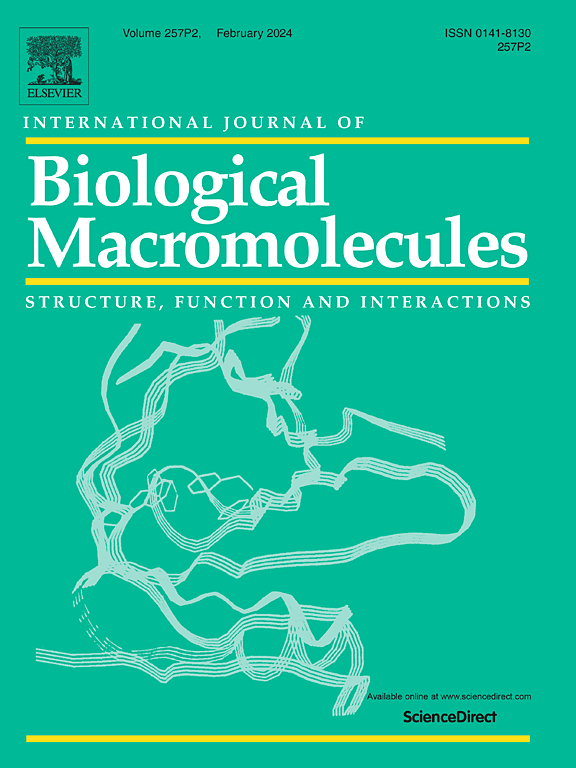Upgrading of a theoretical model for tensile strength of polymer - cellulose nanocrystals system to derive a new equation for interfacial shear strength
IF 8.5
1区 化学
Q1 BIOCHEMISTRY & MOLECULAR BIOLOGY
International Journal of Biological Macromolecules
Pub Date : 2025-07-04
DOI:10.1016/j.ijbiomac.2025.145763
引用次数: 0
Abstract
Cellulose nanocrystals (CNCs) can be used as effective reinforcement for polymers, because of their large surface area and excellent tensile strength. Few models are available to determine the stiffness of CNC-reinforced polymer composites (PNCs). Due to the absence of interphase section and CNC dimensions, the accessible models cannot accurately estimate the properties of PNCs. By focusing on the interphase area, this work develops simple models to calculate the strength and interface shear strength (τ) for PNCs reinforced with CNCs. This study introduces a novel modeling approach that simultaneously predicts both the relative tensile strength (σR) and τ for polymer-CNC nanocomposites by incorporating interphase properties. This dual prediction capability represents a significant advancement over traditional models, offering a more comprehensive insight into the mechanical reinforcement mechanisms. The proposed equations consider the diameter (d), length (l) and concentration of CNCs with the interphase thickness (t) and strength (σi). The proposed models are examined using a variety of experimental data and parametric investigations. There is a good agreement between all predictions and experimental data of PNC strength at different CNC concentrations. The highest relative strength (ratio of PNC strength to strength of matrix) as 8 and maximum τ = 14 MPa are shown at d = 2 nm with l = 500 nm. Additionally, the supreme relative strength of 6 and the uppermost τ = 16 MPa are seen at t = 20 nm with σi = 90 MPa. CNC diameter adversely affects the PNC strength and τ, while longer CNCs with denser and stiffer interphase highly enhance the τ strengthening the PNCs.
改进了聚合物-纤维素纳米晶体体系抗拉强度的理论模型,导出了新的界面抗剪强度方程
纤维素纳米晶体(CNCs)具有较大的表面积和优异的抗拉强度,可作为聚合物的有效增强材料。目前用于确定cnc增强聚合物复合材料(pnc)刚度的模型很少。由于缺少界面截面和CNC尺寸,可访问的模型不能准确估计pnc的性能。通过关注界面面积,本工作开发了简单的模型来计算用cnc增强的pnc的强度和界面抗剪强度(τ)。本研究引入了一种新的建模方法,通过结合界面特性同时预测聚合物- cnc纳米复合材料的相对抗拉强度(σR)和τ。这种双重预测能力代表了传统模型的重大进步,为机械强化机制提供了更全面的见解。本文提出的方程考虑了cnc的直径(d)、长度(l)和浓度与界面厚度(t)和强度(σi)的关系。提出的模型使用各种实验数据和参数调查进行检验。不同CNC浓度下的PNC强度预测与实验数据吻合较好。在d = 2 nm, l = 500 nm处,最大相对强度(PNC强度与基体强度之比)为8,最大τ = 14 MPa。在t = 20 nm, σi = 90 MPa时,合金的最大相对强度为6,最大τ = 16 MPa。CNC直径对PNC的强度和τ有不利影响,而更长的CNC与更密集和更硬的界面相可以显著增强PNC的τ。
本文章由计算机程序翻译,如有差异,请以英文原文为准。
求助全文
约1分钟内获得全文
求助全文
来源期刊
CiteScore
13.70
自引率
9.80%
发文量
2728
审稿时长
64 days
期刊介绍:
The International Journal of Biological Macromolecules is a well-established international journal dedicated to research on the chemical and biological aspects of natural macromolecules. Focusing on proteins, macromolecular carbohydrates, glycoproteins, proteoglycans, lignins, biological poly-acids, and nucleic acids, the journal presents the latest findings in molecular structure, properties, biological activities, interactions, modifications, and functional properties. Papers must offer new and novel insights, encompassing related model systems, structural conformational studies, theoretical developments, and analytical techniques. Each paper is required to primarily focus on at least one named biological macromolecule, reflected in the title, abstract, and text.

 求助内容:
求助内容: 应助结果提醒方式:
应助结果提醒方式:


